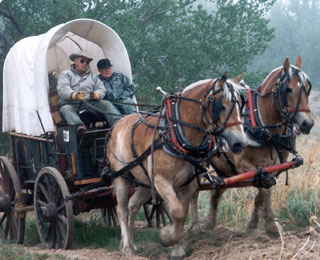
| In years past, this problem was called "Monday morning disease." This was because many draft horses developed this problem when they were rested over a Sunday and then put back to strenuous work on Monday. |
Introduction: Tying-up is a term often used to describe several different muscle conditions common to horses. Other terms used to describe these problems include azoturia, exertional rhabdomyolysis, Monday morning disease, and black water. Current studies indicate that tying-up is really several different diseases that are actually caused by very different things.
Causes: The exact cause of this problem is not always the same in every horse. This makes finding a definite cause for tying-up very challenging. In the past it was thought that all cases of tying-up were related to a situation where a horse was fed a large amount of carbohydrates, allowed to rest, and then worked. This has been proven not to be the case for every horse. Other things have also been suspected to be a potential cause for tying-up. These include overworking a horse that is in poor condition, allowing a horse to overheat, exercise, electrolyte imbalances, mineral deficiencies (vitamin E and selenium), and hormone problems. Horses that are high strung, kept in a stall, prone to stress, or are fed high-energy diets are more likely to develop problems. This problem seems to be more common in female horses, and there is some evidence that this problem could be hereditary. In general, most horses show similar clinical signs no matter what causes the tying-up.
Clinical Signs: Horses with only mild cases may appear lame and stiff. The horse may begin to sweat, act uncomfortable, and is reluctant to move. As the signs progress, the animal is weak in the hind end, has a stiff gait, and may have a brown to red color to the urine (myoglobinuria). Some horses with this problem may have very tight muscles in the back end that can knot up and feel extremely firm. Other horses may look like they are trying to urinate. In more severe cases, the horse is unable to get up.
Diagnosis: Diagnosis of this problem is supported by elevations in blood enzymes that relate to the muscles (AST and CPK). Both of these are found in testing a blood sample, and usually indicate some sort of muscle damage. A muscle biopsy can also help with the diagnosis. When blood work and muscle biopsy are not available, observing the red to brown, almost coffee colored urine with help identify horses that are potentially tying-up.
Treatment: When signs are first noticed, the horse should be kept as quiet and confined as possible. Continued work or exercise will just prolong the problem and more severely compromise the horse. If signs are severe or the horse acts like it may injure itself, sedation may be required. In almost all animals, fluids and NSAIDS (flunixin meglumine, phenylbutazone) will be of benefit. The fluid will help hydrate the horse and help to flush the muscle breakdown products out of the horse’s system. The NSAIDS will help relieve the inflammation and pain. Because the NSAIDS can case kidney and intestinal damage if the horse is dehydrated, caution and direct instructions from a veterinarian should be observed when administering these products.
The horse’s feed should be reduced and all grain should be removed. If the horse is unable to walk or be transported to the veterinarian, have the doctor come to the horse. The condition will only be made worse if the horse is forced to walk or is forced to try and maintain its balance in a moving trailer. If the vet cannot come to the horse, let the horse rest for 24 hours. Be sure to provide the horse with food, plenty of water, and shelter.
If the signs have subsided with rest, continue to have the horse in a confined area for a minimum of 2-3 more days. If the horse still appears to be stiff and in pain, it may need to be rested for up to 2-3 weeks. Once the horse seems to be pain free, slowly start back into normal training, work, or exercise. The horse’s first time back to work after the rest can often be the time when it has another tying-up episode. If signs are mild and/or treatment is begun early, the horse usually has a good prognosis. Be aware, however, that a horse may be prone to additional tying-up episodes in the future.
Prevention: Maintaining a consistent diet and exercise program is essential for preventing this problem. Make sure every horse has access to all the fresh clean water it can drink and supplement the water with electrolytes when necessary. Vitamin E and selenium supplements may also be required with certain diets and areas of the country. Newer studies indicate that feeding dimethylglycine (DMG) or dantrolene sodium may be used to help prevent this problem. It is important to not overwork a horse that is in poor condition. It is also wise to not overfeed a horse on days that it is resting and not expected to work.

|
|